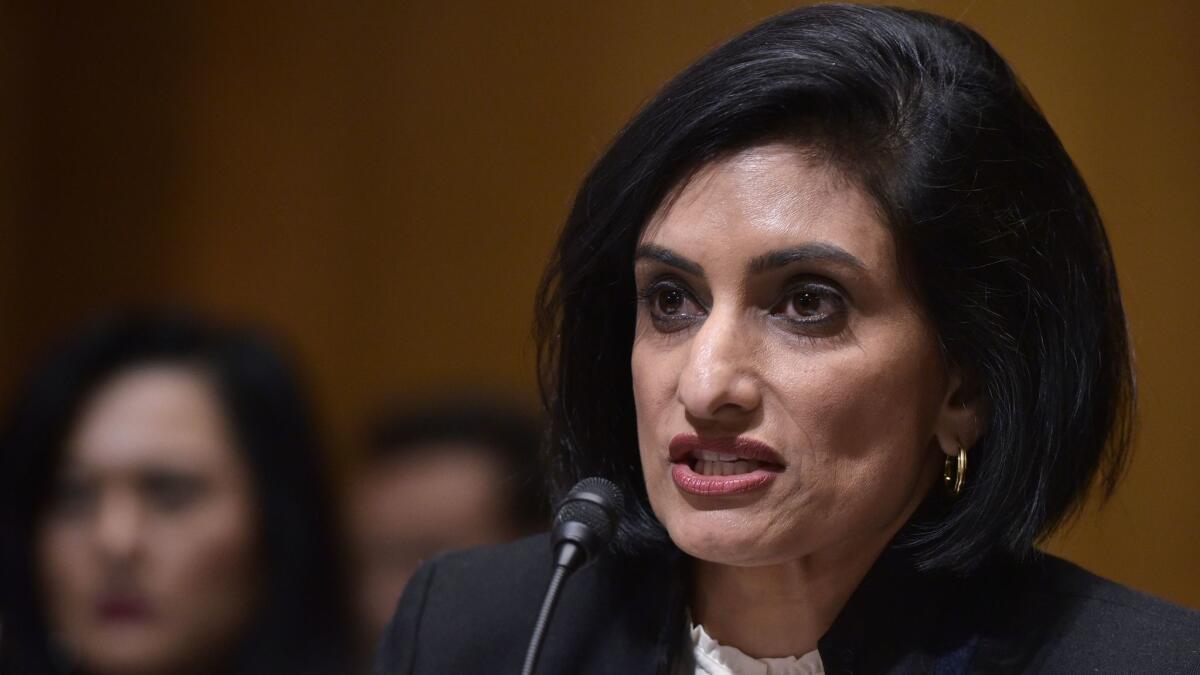Column: How Trump’s Obamacare administrator is taking a hatchet to Obamacare

It’s been well documented that the Trump White House has filled federal agencies with bureaucrats whose life work is destroying the very agencies they’ve been assigned to. But one is in a better position than her fellows to threaten the health of millions of Americans—and she’s been working at that assiduously.
We’re talking about Seema Verma, who as administrator of the Centers for Medicare and Medicaid Services also is effectively the administrator of the Affordable Care Act. In the Trump administration, that has made her the point person for the Trump campaign to dismantle the act, preferably behind the scenes.
Verma is a health consultant who had worked with Republican Indiana Gov. Mitch Daniels and his successor, Mike Pence, to fashion a healthcare program for low-income Hoosiers that was distinguished by its high deductibles and lock-out periods for enrollees who fell behind on their contributions to the plan. Verma labeled that punitive provision “a strong personal responsibility mechanism.” In its initial iteration it was beloved by conservative pundits who don’t have to worry about making ends meet, but rejected by the Obama administration, as it should have been.
We will not just accept the hollow victory of numbers covered.
— Obamacare administrator Seema Verma
Still, Verma had spent enough time in the healthcare field that observers thought she might not be totally egregious as CMS administrator. But then, during her confirmation hearing in February 2017, she let on that she didn’t see why maternity coverage really needed to be mandated for all health policies, since “some women might want maternity coverage, and some women might not want it.”
With that, as I wrote, she displayed either “utter ignorance about how health insurance works, or such desperation for this job that she’s willing to profess ignorance and paper it over with conservative shibboleths about ‘individual choice.’” Anyway, she seemed unaware that before Obamacare there was no such choice in the individual market, since maternity benefits simply weren’t offered, at least at a price anyone could afford.
It wasn’t an auspicious start. But since then she has lived down to our expectations. Verma never has concealed her hostility to Medicaid — especially Medicaid expansion, a provision of the ACA. Her animosity is fueled at least in part by ignorance (willful or otherwise) about the program. Back in November, on the very day that voters in Maine and Virginia were demonstrating full-throated support at the polls for expanding Medicaid in their states, Verma was unspooling a string of misleading statistics and suspect assertions about the program to support a policy of rolling back enrollment.
Badmouthing Medicaid is pretty much the opposite of what a Medicaid administrator should be doing. It’s worse when there’s so little truth to the attack. Verma’s general theme was that simply enrolling more people in Medicaid wouldn’t guarantee they’d get better care, and might even undermine the care provided to existing enrollees. Of the successful expansion of Medicaid rolls under the ACA, she said, “We will not just accept the hollow victory of numbers covered.”
As we observed at the time, this was a remark of almost medieval stupidity. All the evidence available indicates that having coverage under Medicaid produces better health, including mental health, as well as improved family finances. Bringing millions more needy people into the program is no “hollow victory” by any standard. That’s especially so given that the evidence shows that Medicaid patients’ access to care, the quality of their care and their satisfaction with their care are commensurate with that of patients with employer-paid coverage, and hugely superior to the experience of people without insurance.
Verma’s subtext was one parroted by congressional Republicans and right-wing pundits like Ben Domenech of the Federalist (on a network political talk show, no less): The idea is that the Medicaid expansion cut into the resources available for traditional Medicaid, which was aimed at low-income families with children. The expansion also covers childless adults, whom conservatives denigrate as “able-bodied” recipients presumably undeserving of help.
In recent weeks and months, Verma has carried the spear for the administration’s continued attack on the ACA. Last month, after her superiors at the Department of Health and Human Services nixed an Idaho plan to eviscerate the ACA’s mandate of essential health benefits, she suggested to Idaho officials how they could circumvent the ACA’s mandate without being too obvious about it.
She has cleared Kentucky to impose work requirements on Medicaid applicants, a historic first that is probably illegal and almost sure to drive as many as 300,000 enrollees out of the program in the very first year. As 43 experts in healthcare law noted in a friend-of-the-court brief backing a challenge to the Kentucky plan, the addition of work requirements runs exactly counter to the purpose of Medicaid, which is to bring health coverage to more people.
The 43 experts pointed out that Verma’s agency has misrepresented the research it says justifies imposing work requirements on Medicaid. The agency says the research finds that employment leads to better health, so forcing people to find jobs is a boon to their health. But the government has it backward; the research shows that “healthy people are more likely to work, not that working makes people healthier.” In other words, place obstacles in the way of obtaining healthcare, and you’ll end up with a sicker, and less employable, population.
Back on April 5, Verma took to Twitter to “recommend” an article by right-wing healthcare pundit Sally Pipes calling the denial of insurance to people with preexisting conditions and jacking up premiums on older and sicker patients “two valuable strategies for keeping costs down.” (Well, yes, if you exclude sick people from coverage, it will be cheaper for everyone who’s left.) After her tweet was spotlighted by Jonathan Cohn of the Huffington Post, she hastily took it down — but Cohn had kept a screenshot.
Recently, Verma has been talking about doing what ACA expert Charles Gaba called “the stupidest thing possible.” His reference is to a plan Verma has floated to outlaw the so-called silver loading strategy used by California and many other states to reduce the impact of what may be the second-stupidest thing possible, which was President Trump’s decision last year to cancel the billions of dollars in cost sharing reimbursements owed to insurance companies participating in the ACA.
The reimbursements, it may be recalled, covered the reductions in deductibles and co-pays provided to the neediest participants in the ACA. The ACA required the insurers to provide the reductions, but Trump took advantage of a glitch in the ACA to stiff the insurers. As a result, the insurers were poised to raise premiums in 2018 to compensate for their unexpected new obligations.
The “silver loading” states allowed the insurers to load those higher premiums entirely on the benchmark silver ACA plans, which also set the level of premium subsidies the federal government pays for buyers with income of up to 400% of the federal poverty line.
This had several effects. It immunized most of the subsidized families from the premium increase, because the subsidies rose in tandem with the higher silver plan premiums. In some states, this even made higher quality gold plans cheaper than silver plans, because the subsidies rose so much that they covered more of the gold premiums; some bronze plans turned out to be free, because the higher subsidies covered their entire premiums. Silver loading also raised costs for the federal government, which was laying out more money for subsidies.
But the strategy was tougher on unsubsidized households, which would have to pay the higher premiums without any help.
Verma last week told reporters she was considering barring silver loading. This would probably hurt both subsidized and unsubsidized buyers. As David Anderson of Duke observes, if silver loading is barred, “gold plans become very expensive for subsidized buyers and Bronze plans are less likely to be zero premium plans after subsidies.” He reckons this could lead to a 2% to 3% drop in enrollment of on-exchange buyers in many states. Andrew Sprung estimates on his xpostfactoid blog that as many as 2 million enrollees would be worse off from the various permutations of the proposed policy.
Trump and Verma would no doubt declare this a wonderful thing. But it would be a sign of pure ineptitude or pure malevolence (take your pick). “Having accidentally made Obamacare a little bit better,” writes Kevin Drum at Mother Jones, “they’re now desperately scuttling around for ways to make sure their sabotage works the way they wanted it to. Banning silver loading would do this.”
Republicans in Congress didn’t have the votes to repeal the Affordable Care Act, so they’ve taken to underhanded stunts to try to accomplish the same thing, with Trump’s help. Their actions include effectively eliminating the individual mandate, which will guarantee that the pool of ACA enrollees will be sicker next year than last year, driving up costs; and promoting cheaper, skimpier short-term health plans, which will leave their policyholders without crucial coverage or consumer protections just at the point they need these benefits for their health, while also draining healthier enrollees from full-benefit ACA plans.
These actions will almost certainly lead to a spike in premiums for 2019. “It’s just still a nasty soup right now that’s brewing,” Matt Eyles, a top executive at America’s Health Insurance Plans, the industry lobbying arm, warned at a Washington conference last week. Trump and his fellow Republicans will be entirely responsible for the fallout, but they’ll have Seema Verma to thank for running interference.
Keep up to date with Michael Hiltzik. Follow @hiltzikm on Twitter, see his Facebook page, or email [email protected].
Return to Michael Hiltzik’s blog.
More to Read
Inside the business of entertainment
The Wide Shot brings you news, analysis and insights on everything from streaming wars to production — and what it all means for the future.
You may occasionally receive promotional content from the Los Angeles Times.











